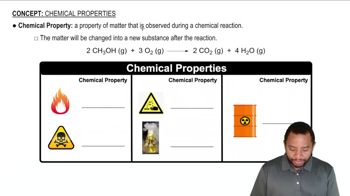Urea (CH4N2O) is a common fertilizer that is synthesized by the reaction of ammonia (NH3) with carbon dioxide: 2 NH3(aq) + CO2(aq) → CH4N2O(aq) + H2O(l) In an industrial synthesis of urea, a chemist combines 136.4 kg of ammonia with 211.4 kg of carbon dioxide and obtains 168.4 kg of urea. Determine the limiting reactant, theoretical yield of urea, and percent yield for the reaction.
Ch.4 - Chemical Reactions and Chemical Quantities

Chapter 4, Problem 53
Write the balanced chemical equation for the reaction of solid strontium with iodine gas.
 Verified step by step guidance
Verified step by step guidance1
Identify the reactants and products: Strontium (Sr) is a solid metal, and iodine (I2) is a diatomic gas. The product of their reaction is strontium iodide (SrI2).
Write the unbalanced chemical equation: Sr(s) + I2(g) → SrI2(s).
Count the number of atoms of each element on both sides of the equation. Initially, you have 1 Sr atom and 2 I atoms on the reactant side, and 1 Sr atom and 2 I atoms on the product side.
Check if the equation is balanced. In this case, the equation is already balanced as there is an equal number of each type of atom on both sides.
Confirm the physical states of each compound: Strontium is a solid (s), iodine is a gas (g), and strontium iodide is a solid (s).

Verified video answer for a similar problem:
This video solution was recommended by our tutors as helpful for the problem above.
Video duration:
1mWas this helpful?
Key Concepts
Here are the essential concepts you must grasp in order to answer the question correctly.
Chemical Reactions
A chemical reaction involves the transformation of reactants into products through the breaking and forming of chemical bonds. In this case, solid strontium (Sr) reacts with iodine gas (I2) to form strontium iodide (SrI2). Understanding the nature of reactants and products is essential for writing balanced chemical equations.
Recommended video:
Guided course

Chemical Properties
Balancing Chemical Equations
Balancing a chemical equation ensures that the number of atoms of each element is the same on both sides of the equation, adhering to the law of conservation of mass. This involves adjusting coefficients in front of compounds to achieve balance. For the reaction of strontium and iodine, the balanced equation must reflect the correct stoichiometry of the reactants and products.
Recommended video:
Guided course

Balancing Chemical Equations
Ionic Compounds
Ionic compounds are formed when metals react with nonmetals, resulting in the transfer of electrons and the formation of charged ions. In this reaction, strontium, a metal, donates electrons to iodine, a nonmetal, leading to the formation of strontium iodide (SrI2), an ionic compound. Recognizing the properties of ionic compounds helps in predicting the products of the reaction.
Recommended video:
Guided course

Ionic Compounds Naming
Related Practice
Textbook Question
Textbook Question
Many computer chips are manufactured from silicon, which occurs in nature as SiO2. When SiO2 is heated to melting, it reacts with solid carbon to form liquid silicon and carbon monoxide gas. In an industrial preparation of silicon, 155.8 kg of SiO2 reacts with 78.3 kg of carbon to produce 66.1 kg of silicon. Determine the percent yield for the reaction.
1
views
1
rank
Textbook Question
Write the balanced chemical equation for the reaction of solid lithium with liquid water.
Textbook Question
Write the balanced chemical equation for the reaction of solid potassium with liquid water.
Textbook Question
Write the balanced equation for the reaction of hydrogen gas with bromine gas.
1
views
